Having the best car cover for your vehicle is a must because you never know when you might need it. No matter if you want to store your car for a week or months on end, a car cover plays an important role in safety and aesthetics. Sometimes, the cover plays more of a psychological role. We will address all of this in the following article.
In order to help you bring a good decision, we decided to compile a comprehensive buying guide and our unbiased car cover reviews. So, let’s jump right into it!
See The Quick Comparison Chart
Are Car Covers Worth It?
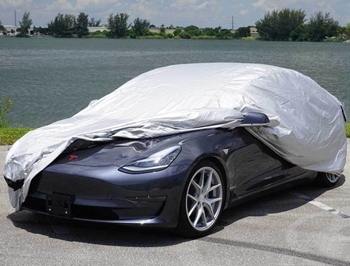 Keeping your car safe and sound is definitely important, especially when you know you won’t be using it for a while. At that time, it’s imperative to keep the car stored in good conditions, safe from the influence of adverse weather, the sun’s UV rays, and dust. When your car stays unprotected for a while, many bad things can happen. If it’s exposed to the sun and the rain for a long time, not only will the paintwork suffer, but the metal might rust, and the plastic trims may become brittle and easily breakable. This can result in severe danger, and it will surely decrease the life expectancy of your car, the pleasure you get from driving it, and the eventual resale value. Even if your car is parked indoors, in a garage, it’s not completely safe in the long run. Dust and condensation easily accumulate and create a tough film over the paintwork. As a result, your car paint will not only look dull but also become very sticky, inviting more and more dust, with the film finally requiring heavy scrubbing to be removed.
Keeping your car safe and sound is definitely important, especially when you know you won’t be using it for a while. At that time, it’s imperative to keep the car stored in good conditions, safe from the influence of adverse weather, the sun’s UV rays, and dust. When your car stays unprotected for a while, many bad things can happen. If it’s exposed to the sun and the rain for a long time, not only will the paintwork suffer, but the metal might rust, and the plastic trims may become brittle and easily breakable. This can result in severe danger, and it will surely decrease the life expectancy of your car, the pleasure you get from driving it, and the eventual resale value. Even if your car is parked indoors, in a garage, it’s not completely safe in the long run. Dust and condensation easily accumulate and create a tough film over the paintwork. As a result, your car paint will not only look dull but also become very sticky, inviting more and more dust, with the film finally requiring heavy scrubbing to be removed.
A car cover can give you peace of mind when you’re on vacation, or while your beloved summer vehicle is stored away during the cold seasons. These covers are designed to keep your vehicle protected from the adverse effects of the environment, whether it’s parked outside or in a garage. With many high-quality car covers on the market costing less than a hundred dollars, we can’t see a reason to pass on the opportunity. It’s a good, worthwhile investment that truly pays off down the road.
Benefits of Car Covers
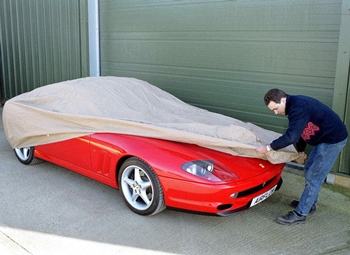 A good car cover can take care of many of these problems for you. Instead of letting your car slowly but surely deteriorate, you can prevent many of the common problems with one of these pieces of car gear. Let’s take a look at the ways in which a car cover can make your life easier.
A good car cover can take care of many of these problems for you. Instead of letting your car slowly but surely deteriorate, you can prevent many of the common problems with one of these pieces of car gear. Let’s take a look at the ways in which a car cover can make your life easier.
1. Protection Against the Effects of the Weather
From rain, through snow and hail, to the sun’s UV rays, the weather can have seriously detrimental effects on your car in the long run. If you leave your car sitting parked outside for a while, you should protect it from the effects of the weather. And there’s no better way to do this than with a high-quality car cover that’s fit for outside use. It will protect your car from rust and brittleness resulting from water and sun exposure, and it will make sure your car stays beautiful for a long time by protecting your car paint from stains and discoloration. A good waterproof car cover will ensure your vehicle avoids most of the most common problems that appear as a result of prolonged exposure to the forces of nature.
2. Protection Against Scratches, Dents, Rust, and Mildew
Your car can easily get scratches and dents if it stays exposed to the environmental factors for a long time, especially if it’s parked outside. On the other hand, rust and mildew frequently appear on cars that stay unprotected in humid environments. No matter if your car is out in the open or parked in a garage, moisture finds its way into the cracks and crevices, and there it can cause problems that are not only unsightly but affect the general performances of the vehicle itself. Keeping your car properly sheltered from these influences can help you save money on repairs, and keep your car in top condition for a long time. Eventually, this also raises its resale value. For the small investment that a car cover is, this can bring an enormous return on investment.
3. Protection Against Thieves and Curious Eyes
If your car is not parked inside of a closed garage, it faces a risk of being broken into or stolen. While a car alarm can help keep your car safe, it’s always a good idea to have an additional layer of protection. A car cover will help keep thieves at bay as it’s simply too much work for a criminal to invest in removing the car cover. In fact, they may not be interested in your car at all, because they won’t know what’s under the covers – and whether the risk of taking the covers off can pay off for them at all. Most frequently, car thieves simply aren’t interested in cars with covers.
Best Car Covers Comparison Chart
| PRODUCT | DETAILS | ||
|---|---|---|---|
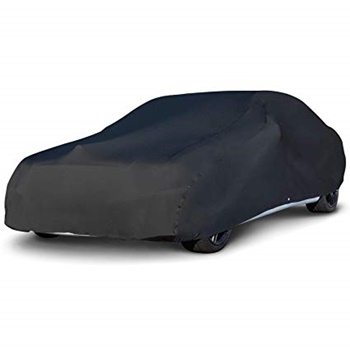 | Budge BSC-3 Black |
| View On Amazon |
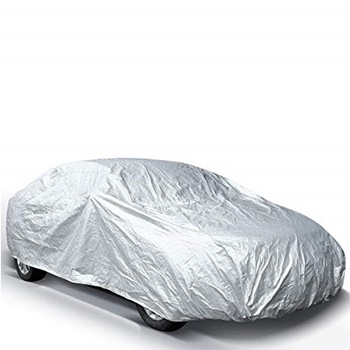 | Ohuhu Car Cover for Sedan |
| View On Amazon |
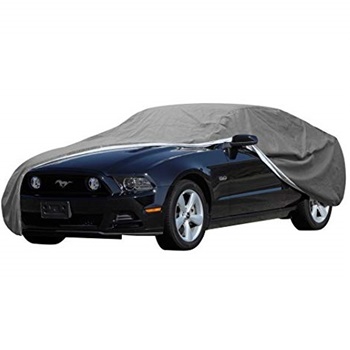 | OxGord Signature Car Cover |
| View On Amazon |
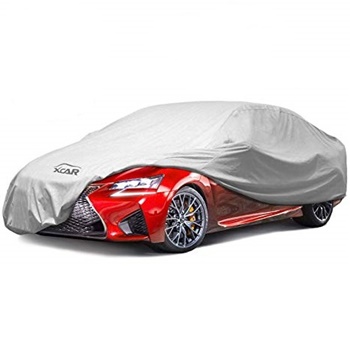 | XCAR Breathable Dust Prevention Car Cover |
| View On Amazon |
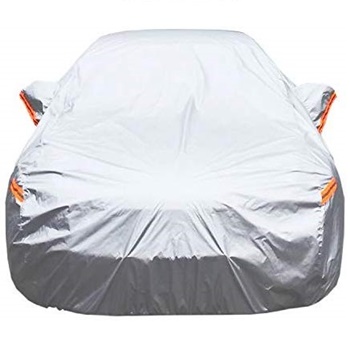 | CARBABA Universal Car Cover for Sedan |
| View On Amazon |
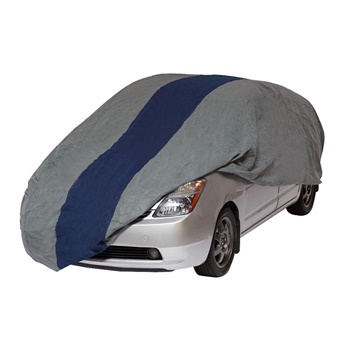 | Duck Covers Double Defender Hatchback Cover |
| View On Amazon |
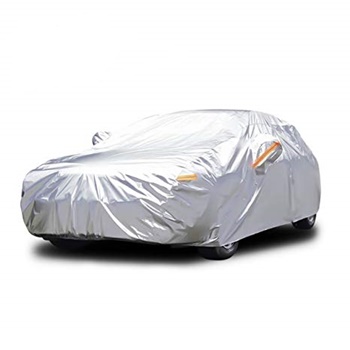 | Audew All Weather Car Cover |
| View On Amazon |
Best Car Cover Reviews
1. Budge BSC-3 Black
 Our next pick is a premium quality car cover model made by Budge. This car cover is perfect for sedan vehicle collectors, and it’s designed to keep your car in pristine conditions no matter how long you keep it parked inside of your garage. It fits any sedan car that’s up to 200 inches long, and it’s somewhat stretchy, conforming to the curves of your car. It’s made out of two layers of material – an outer layer which is a blend of nylon and polyester, and a soft inner lining made of fleece, which is lightweight and thin, and never scratch your car. It’s perfect for protection against airborne pollutants like dust, grime, and dirt. Still, it remains very breathable, allowing you to cover your car up right after washing it, without fear that it will cause corrosion or mildew buildup. The securing mechanism on this cover is an elastic hem, which never scratches your vehicle. This hail protection car cover is not suitable for outside use, and it will not protect your car from rain and snow.
Our next pick is a premium quality car cover model made by Budge. This car cover is perfect for sedan vehicle collectors, and it’s designed to keep your car in pristine conditions no matter how long you keep it parked inside of your garage. It fits any sedan car that’s up to 200 inches long, and it’s somewhat stretchy, conforming to the curves of your car. It’s made out of two layers of material – an outer layer which is a blend of nylon and polyester, and a soft inner lining made of fleece, which is lightweight and thin, and never scratch your car. It’s perfect for protection against airborne pollutants like dust, grime, and dirt. Still, it remains very breathable, allowing you to cover your car up right after washing it, without fear that it will cause corrosion or mildew buildup. The securing mechanism on this cover is an elastic hem, which never scratches your vehicle. This hail protection car cover is not suitable for outside use, and it will not protect your car from rain and snow.
Pros
- The stretchy material perfectly suits any car design
- The breathable fabric is ideal for indoor storage
Cons
- This premium model comes at a higher price point
2. Ohuhu Car Cover for Sedan
 Our next pick is made by Ohuhu, and it’s a very affordable model. This single-layer polyester taffeta model can be used both indoors and outdoors. The silver-colored material has reasonable breathability, which is not as high as cotton, but sufficient for indoor car storage. On the other hand, it’s quite water-resistant, and it easily protects your car from scratches and stains, making it a solid outdoor model as well. Even though there is only one layer of the material, this product can provide fair protection from water, dirt, and UV rays. Sadly, the material itself is not of very high quality, so it may tear in a highly demanding environment. Still, the price point justifies the somewhat low quality. The fastening mechanism is very good and fit for use in both a garage and a windy street. The cover comes equipped with both an elastic hem, and adjustable length buckled straps. It fits any sedan vehicle that’s up to 200 inches long. It comes packed in a carrying bag, so it’s also a good portable option.
Our next pick is made by Ohuhu, and it’s a very affordable model. This single-layer polyester taffeta model can be used both indoors and outdoors. The silver-colored material has reasonable breathability, which is not as high as cotton, but sufficient for indoor car storage. On the other hand, it’s quite water-resistant, and it easily protects your car from scratches and stains, making it a solid outdoor model as well. Even though there is only one layer of the material, this product can provide fair protection from water, dirt, and UV rays. Sadly, the material itself is not of very high quality, so it may tear in a highly demanding environment. Still, the price point justifies the somewhat low quality. The fastening mechanism is very good and fit for use in both a garage and a windy street. The cover comes equipped with both an elastic hem, and adjustable length buckled straps. It fits any sedan vehicle that’s up to 200 inches long. It comes packed in a carrying bag, so it’s also a good portable option.
Pros
- A very affordable car cover option
- It can be used both indoors and outdoors
Cons
- The materials are not of a very high quality
3. OxGord Signature Car Cover
 The next model on our list is an OxGord signature car cover. The price point of this product is mid-range, so it’s quite a good deal for what it offers. This model fits sedan cars that are up to 204 inches long, which is among the longer ones on the market. This lovely grey model is made out of 5 layers of good quality materials, so it’s quite worthwhile and suitable for both indoor and outdoor use. The layers include three layers of spun bound polypropylene, one layer of micro-porous film, and an inner soft fleece layer. This model is fairly weather-resistant, and it can protect your car from moderate weather conditions. However, it’s water-resistant only to a point, and it cannot handle heavy rains and snowstorms. It’s secured with reinforced elastic hems and additionally fastened with a string drawn through security grommets. With the model, you get a handy storage bag, so you can easily carry the car cover anywhere with you. Additionally, it comes with an antenna patch.
The next model on our list is an OxGord signature car cover. The price point of this product is mid-range, so it’s quite a good deal for what it offers. This model fits sedan cars that are up to 204 inches long, which is among the longer ones on the market. This lovely grey model is made out of 5 layers of good quality materials, so it’s quite worthwhile and suitable for both indoor and outdoor use. The layers include three layers of spun bound polypropylene, one layer of micro-porous film, and an inner soft fleece layer. This model is fairly weather-resistant, and it can protect your car from moderate weather conditions. However, it’s water-resistant only to a point, and it cannot handle heavy rains and snowstorms. It’s secured with reinforced elastic hems and additionally fastened with a string drawn through security grommets. With the model, you get a handy storage bag, so you can easily carry the car cover anywhere with you. Additionally, it comes with an antenna patch.
Pros
- Fastened with elastic hems and drawstring
- Five layers of high-quality materials
Cons
- Not completely waterproof in heavy rains
4. XCAR Breathable Dust Prevention Car Cover
 Our next pick is an XCar cover that’s one of the most affordable models available on the market. This three-layer car cover fits sedan vehicles of up to 200 inches in length. It’s made for both indoor and outdoor use, and the fabric is very breathable, making corrosion unlikely even if you cover your car while it’s still damp. This grey colored car cover consists of three layers of spun bound polypropylene, and it offers fair dust and UV ray protection. However, this cover is not water-resistant, so it’s not a good choice for people living in areas with a lot of rain or snow. It does shield your car from bird droppings and tree sap and scratches as well. It has an elastic hem and a strap in the corners, and in the middle, you can use a drawstring or a cable to tie it around your car. In fact, you get an anti-theft cable and a lock with a set of keys along with the car cover.
Our next pick is an XCar cover that’s one of the most affordable models available on the market. This three-layer car cover fits sedan vehicles of up to 200 inches in length. It’s made for both indoor and outdoor use, and the fabric is very breathable, making corrosion unlikely even if you cover your car while it’s still damp. This grey colored car cover consists of three layers of spun bound polypropylene, and it offers fair dust and UV ray protection. However, this cover is not water-resistant, so it’s not a good choice for people living in areas with a lot of rain or snow. It does shield your car from bird droppings and tree sap and scratches as well. It has an elastic hem and a strap in the corners, and in the middle, you can use a drawstring or a cable to tie it around your car. In fact, you get an anti-theft cable and a lock with a set of keys along with the car cover.
Pros
- A very affordable option
- Suitable for indoor and outdoor use
Cons
- This model is not waterproof at all
5. CARBABA Universal Car Cover for Sedan
 Carbaba makes the next model we want to include on our list, and it’s a universal sedan vehicle cover that suits any cars up to 190 inches in length. The cover model is on the lower mid-range price point, and it’s a good model for cars that are parked both indoors and outdoors. This model is very breathable, so you can freely cover a damp car with it, knowing that the moisture will evaporate quickly, never kickstarting corrosion. This model is made out of only one layer of fabric, but the nonwoven PEVA material is coated with a PU layer, which makes it water-resistant and sturdy.
Carbaba makes the next model we want to include on our list, and it’s a universal sedan vehicle cover that suits any cars up to 190 inches in length. The cover model is on the lower mid-range price point, and it’s a good model for cars that are parked both indoors and outdoors. This model is very breathable, so you can freely cover a damp car with it, knowing that the moisture will evaporate quickly, never kickstarting corrosion. This model is made out of only one layer of fabric, but the nonwoven PEVA material is coated with a PU layer, which makes it water-resistant and sturdy.
This car cover can handle any weather and environmental conditions, from rains to hot summer sun’s UV rays, along with any contaminant that may scratch or stain your car’s paint. However, it’s not a hundred percent waterproof, so some water may seep in during very heavy rains or snows. When it comes to a fastening mechanism, this model comes with both an elastic hem and buckled straps. Across the cover, there are reflective strips, which ensure your car won’t be hard to notice in the dark. This can help avoid many accidents.
Pros
- A very breathable material choice
- Comes with reflective strips that enhance visibility
Cons
- Not completely waterproof in heavy rains
6. Duck Covers Double Defender Hatchback Cover
 Our next pick is a stylish grey and blue Duck Covers model for hatchback vehicles that have up to 163 inches in length. For a middle-range price point, this car cover is a good choice for any hatchback car. It’s secured around your car with an elastic hem, and grommets for drawstring, rope, or cable. This car cover can be used outside, as it’s water-resistant, but it’s designed to protect cars from the issues with indoor parking conditions. In fact, the triple-layer fabric is exceptionally breathable, making it a great choice for car owners that may not have the time to wait for their vehicle to dry completely before covering it. Getting a cover made out of a breathable material will help you avoid rusting and mildew. The cover will protect your car from scratches from any contaminants indoors or outdoors, and it will not let dust or sap ruin your car paint. However, it’s not completely waterproof, so we wouldn’t recommend relying on it in heavy rains.
Our next pick is a stylish grey and blue Duck Covers model for hatchback vehicles that have up to 163 inches in length. For a middle-range price point, this car cover is a good choice for any hatchback car. It’s secured around your car with an elastic hem, and grommets for drawstring, rope, or cable. This car cover can be used outside, as it’s water-resistant, but it’s designed to protect cars from the issues with indoor parking conditions. In fact, the triple-layer fabric is exceptionally breathable, making it a great choice for car owners that may not have the time to wait for their vehicle to dry completely before covering it. Getting a cover made out of a breathable material will help you avoid rusting and mildew. The cover will protect your car from scratches from any contaminants indoors or outdoors, and it will not let dust or sap ruin your car paint. However, it’s not completely waterproof, so we wouldn’t recommend relying on it in heavy rains.
Pros
- A stylish look on a soft, high-quality fabric
- The fabric is very breathable
Cons
- Not entirely waterproof in heavy rains
7. Audew All Weather Car Cover
 Audew’s all-weather car cover is a great outdoor cover option that comes at a mid-range price. The most amazing property of this particular model is its six layers of high-quality materials chosen for their weather-resistant properties. The dust and waterproof fabric is a combination of a nonwoven material, two layers of PE, an aluminum sheet, EVA, and cotton. Together, they create a resilient, durable fabric that can protect your car from anything the world throws at it, including water, snow, UV rays, and dust. It comes with straps and buckles with which you can secure the cover to your car, but it also has an all-round elastic hem that holds it fastened to your car evenly across the surface. The car cover has several reflective strips, which increase nighttime visibility, making your car safe from accidental collisions in the dark. It fits any sedan vehicle that is less than 187 inches long. It comes neatly packed up in a storage bag, so it’s easy to carry around as well.
Audew’s all-weather car cover is a great outdoor cover option that comes at a mid-range price. The most amazing property of this particular model is its six layers of high-quality materials chosen for their weather-resistant properties. The dust and waterproof fabric is a combination of a nonwoven material, two layers of PE, an aluminum sheet, EVA, and cotton. Together, they create a resilient, durable fabric that can protect your car from anything the world throws at it, including water, snow, UV rays, and dust. It comes with straps and buckles with which you can secure the cover to your car, but it also has an all-round elastic hem that holds it fastened to your car evenly across the surface. The car cover has several reflective strips, which increase nighttime visibility, making your car safe from accidental collisions in the dark. It fits any sedan vehicle that is less than 187 inches long. It comes neatly packed up in a storage bag, so it’s easy to carry around as well.
Pros
- Made out of 6 layers of high-quality materials
- Has both elastic hems and buckled straps
Cons
- Many find the rear side of too large for sedan vehicles
What Can Happen to Your Car Without a Car Cover?
Your car is not safe when it’s stored uncovered for a long time, no matter if it’s indoors or outdoors. In fact, there are many things that can go wrong, and the odds get higher the more time passes. Let’s take a look at some of the things against which a car cover can protect your vehicle.
1. Effects of the Weather
1.1. Rain and Snow
Having your car parked outdoors even for a short while can bring trouble. The effects of the weather can get worse the more time your car spends parked at the same place, especially if it’s not sheltered from rain, snow, and hail. While cars are, of course, to some extent resistant to water, their resistance is not perfect, and it’s dangerous for a car to stay in wet conditions for prolonged periods of time. Rainwater seeps into cracks, and the condensation can kickstart corrosion, finally resulting in rusty patches. This is especially dangerous when there is long-lasting snow that lingers in your car. On the other hand, hail does not only damage your vehicle because it’s wet, but it can also cause dents and scratches on the surface of your car. That is why a hail car cover is a good idea.
1.2. The Sun
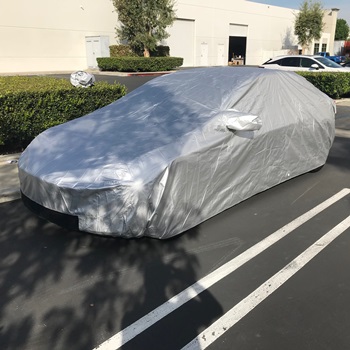 If you’ve ever left a piece of plastic furniture out in the open for a long time, you know that the sun’s UV rays quickly make the paint fade. Even worse than that, the plastic becomes brittle and frail after a while. The same can happen to the paintwork and the plastic parts of your car, especially the trims and the bumpers. This can be very dangerous, as the role of the bumpers is to protect you and your vehicle’s interior mechanism in the case of a collision. Because of that, you want your bumpers to be in good shape (you can check our bumper guard reviews for that), and not weakened by too much exposure to UV rays.
If you’ve ever left a piece of plastic furniture out in the open for a long time, you know that the sun’s UV rays quickly make the paint fade. Even worse than that, the plastic becomes brittle and frail after a while. The same can happen to the paintwork and the plastic parts of your car, especially the trims and the bumpers. This can be very dangerous, as the role of the bumpers is to protect you and your vehicle’s interior mechanism in the case of a collision. Because of that, you want your bumpers to be in good shape (you can check our bumper guard reviews for that), and not weakened by too much exposure to UV rays.
2. Environmental Effects
2.1. Birds and Critters
Birds can pose a great danger to your car’s paintwork. Bird droppings are one of the top issues for people who tend to park their cars outside. However, while droppings are easy to remove within a couple of days, they become a worse issue with time. After a week or more, dropping from a bird may leave a permanent stain or discoloration on your car’s paint.
On the other hand, critters like squirrels and mice, but also cats, can cause paintwork damage that goes beyond polishing. Their claws can leave unsightly scratches and scuffs.
2.2. Trees
You may feel it’s safer to park your car under a tree, as it can shelter your car from some of the rain and snow that falls while you’re away. However, this is not a great idea. While falling pine cones and acorns can cause minor scratches, tree sap is a bigger problem for most vehicles parked outside. Just like bird droppings, the more time passes, the more the tree sap solidifies on your car’s paint. With time, it damages the paint clear coat, which is there to protect the surface of your car. Tree sap is not only a drag to clean, but it can also result in permanent damage in the form of discoloration and stains.
2.3. Passersby and Thieves
Other people can also pose a risk to your car that’s not negligible. If you live in a neighborhood with many children, you may understandably be fearful of a basketball ending up leaving a dent on your car’s metalwork. That’s not so rare. Luckily, the car covers that can shield your car from hail can also help in these cases.
On the other hand, you may be worried that someone will try to pry open your car door or hot-wire and drive your car away. The chances of this are much higher if you keep any valuables visible inside of your car. Cars with covers are far less likely to be a target of car thieves. Not only will they simply not be interested in a car they can’t inspect, but taking the cover off is a part of the process that simply takes too much time to a criminal.
3. Indoor Effects
3.1. Dust
Even cars that are parked inside face significant problems when they stay parked for too long without proper protection. Dust is one of the biggest enemies of a beautiful car. It doesn’t simply fall and collect into an easy to wipe layer. In most cases, the reality is that dust gets caked onto the surface, creating a film of grime that requires scrubbing or heavy chemicals to remove. In turn, this causes permanent scratches and swirl marks.
3.2. Condensation
Any garage will have some level of moisture present, no matter how well-made it is or how much care you take of it. Condensation settles on the surface of your car, causing numerous problems. From mildew to rust, there are many ways in which garage moisture can damage your vehicle in the long run.
Car Cover Types
There is a variety of car covers out there. They differ in many ways, from the choice of materials, over the number of layers, to the dimensions and fitting they’re made in. However, when we boil it all down, there are only two different basic types of car covers – those designed for indoor, and for outdoor use. Let’s take a look at how they compare, and what the exact differences are.
1. Indoor Car Covers
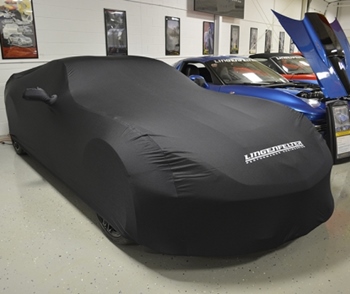 As you can imagine, indoor car covers are made to perfectly suit cars that are parked in indoor garages. Their choice of materials focuses on protection against indoor-specific moisture and dust.
As you can imagine, indoor car covers are made to perfectly suit cars that are parked in indoor garages. Their choice of materials focuses on protection against indoor-specific moisture and dust.
Indoor car covers typically only have one layer of material. That’s because the most important job of an indoor cover is to protect against dust. Even though this material is typically thin, it provides sufficient protection, taking any dust that would otherwise fall on the surface of your vehicle. This way, your car can stay beautiful for a long time.
When you cover your car inside, you want to have a breathable material that lets condensed moisture evaporate. This way, indoor car covers are protecting your car from the buildup of mildew, or in the worst-case scenario, rust.
Because of the storage conditions, indoor car covers do not typically have intricate or heavy-duty securing mechanisms like straps and bungee cords. In most cases, they have an elastic hem which ensures the cover stays in place, but that wouldn’t be able to withstand strong wind were the car parked outside.
2. Outdoor Car Covers
Outdoor car covers require completely different qualities compared to the indoor models. In order to protect your car, covers designed for a car parked outdoors needs to be able to handle a plethora of effects. Because of that, they’re typically made out of multiple layers of various suitable materials, usually at least three layers. These materials need to withstand a large variety of adverse forces, so they are combined to get the best results.
Outdoor car covers need to withstand bad weather conditions. In order to ward your car of rain and snow, the car cover for snow must be waterproof. If you’re interested in hail-proof car covers, you may encounter come inflatable covers that shield your vehicle from all sides. The UV protection is also very important in outdoor car covers, so they come with layers of suitable materials. But they also typically come in brighter shades like white and silver, which tend to reflect more of the sun’s harmful rays, not letting them reach the vehicle as a darker color would. Some outdoor car covers have a layer of aluminum or similar impregnable material that prevents any scratches from reaching the surface of the vehicle.
If the wind is a problem in an area, a car cover that has a snug fit and a reliable securing mechanism is a must. Outdoor car covers typically come equipped with heavy-duty straps and cords which hold it tied down to the car, giving you peace of mind. If they don’t come with additional securing mechanisms, they have elastic hems that are better made and stronger than the indoor models typically have.
Car Cover Buying Guide
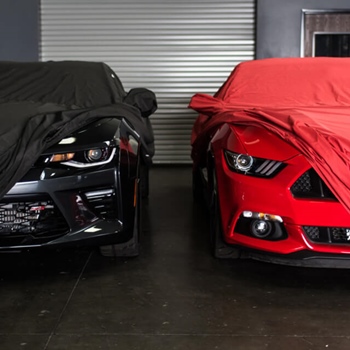 Choosing the right car cover seems easier said than done. After all, the market is full of different models, and they seem quite similar at first glance. However, you may make a mistake if you buy just any model you come across first. Buying a car cover that truly answers your needs and addresses your particular pain points is the best way to ensure your investment pays off. Because of that, we prepared a buying guide which outlines all of the most important car cover features. We hope it helps you bring an informed decision, and that you’ll know exactly what to look for with its help.
Choosing the right car cover seems easier said than done. After all, the market is full of different models, and they seem quite similar at first glance. However, you may make a mistake if you buy just any model you come across first. Buying a car cover that truly answers your needs and addresses your particular pain points is the best way to ensure your investment pays off. Because of that, we prepared a buying guide which outlines all of the most important car cover features. We hope it helps you bring an informed decision, and that you’ll know exactly what to look for with its help.
1. Dimensions
1.1. Fitting
The first thing you need to pay attention to when choosing a car cover is whether it comes in the right fit for your vehicle. Sedans, hatchbacks, SUVs, and trucks, all need differently designed and sewn car covers because of their differing shapes. While a truck cover would most likely fit a sedan, it will not provide a tight enough fit to protect it against moisture or dust properly. Because of that, it’s important to get a separate car cover for each vehicle you own, by paying attention to get the right fitting.
Furthermore, the dimensions of a car cover are important, especially the length of the vehicle. Car covers for sedan vehicles come in different lengths, and the difference can be quite dramatic. A shorter vehicle may be as short as 180 inches, while a longer one may exceed 200 inches. Getting the right dimensions is important, so make sure to measure your vehicle beforehand!
1.2. Portability
Sadly, bigger car covers also mean they’re harder to pack up and carry around. Smaller car covers are naturally more portable. However, if you need to ensure easy and simple portability, we’d recommend looking for a car cover that’s lightweight because of the materials it’s made of, instead of its dimensions. It’s important to get the right-sized cover, while the difference in weight between 3- and 5-layer covers can be quite large, with their performances not being necessarily that different.
2. Fabric
2.1. Breathability and Waterproofness
When choosing an ideal car cover, you should make sure it can protect your car from all of the weather and environmental effects that can damage your vehicle. Consider the weather in your area, and pick a cover that best suits that weather. This is especially important for cars that will be parked outdoors.
Some of the most commonly sought after features are breathability and resistance to water. Breathability is especially important for the cars parked in garages. It will ensure that condensation doesn’t get trapped under the cover, as too much-collected condensation can cause rust and mildew. On the other hand, your car must be protected from rain and snow if it’s parked outside for prolonged periods of time, so waterproof car covers are the best choice for outdoor parking.
2.2. Layers
Different materials have different effects and capabilities when it comes to car covers. That’s why outside car covers frequently have several layers. Look for the right combination of materials that best tackles the weather in your area.
Any car cover you get should have a soft inner layer. Typically, this is either soft cotton or fleece. This layer touches your paintwork, so it should be soft and not attract dust. Cotton and fleece are also very breathable, so single-layer indoor car covers are frequently made out of these two materials.
Some outer layers of car covers include polymers like polyethylene. These are very good for waterproofing your vehicle. This material is also tough, so polyethylene covers tend to be very durable. Aluminum is another frequently used material. It’s not only waterproof, but it also reflects UV rays, not letting them pierce through the cover and damage your car’s plastic parts. Aluminum also prevents overheating in the summer.
2.3. Color
If you park your car inside a garage, the color of your car cover does not make a difference. However, if you’re buying an outside car cover, we’d recommend going for a lighter colored model. That’s because light shades like white and silver reflect more of the sun’s UV rays, while darker colors absorb more. Of course, you want as little of the UV rays to reach your car as possible, so a lighter colored car cover is a great idea for cars that stay parked outside.
3. Fastening Method
Another aspect of car covers you should consider is how you tightly fastened you need it to be. There are three basic ways of fastening that are widely used with car covers – elastic hems, straps, or a combination of the two. If you intend to park your car indoors, you probably don’t need to fasten the covers tightly. However, if your car will stay outside, and especially if you live in a windy area, it’s crucial to have it snug and secure in your car.
In general, elastic hems provide fair security, and its upside is that it keeps the covers tight across the entire area of the hem. On the other hand, straps provide exceptionally strong ties, but you may get some flapping areas on the peripheral parts of the cover. Of course, the combination of the two methods provides the best possible fit.
How to Install a Car Cover?
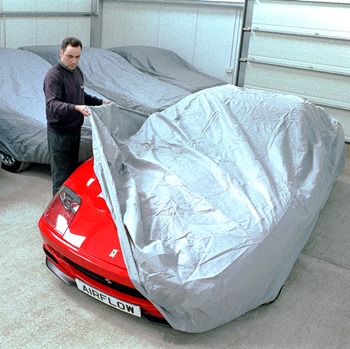 Installing a car cover is exceptionally easy to do. Even considering that there is a variety of models, all of which may have different fastening mechanisms, the basic way of installing car covers is the same with most models. We will give a brief overview of the basic steps of installation of any car cover, but for particular details, you should check the website of your particular cover’s manufacturer or a user manual that you got with your product.
Installing a car cover is exceptionally easy to do. Even considering that there is a variety of models, all of which may have different fastening mechanisms, the basic way of installing car covers is the same with most models. We will give a brief overview of the basic steps of installation of any car cover, but for particular details, you should check the website of your particular cover’s manufacturer or a user manual that you got with your product.
1. Before You Put Covers On
Whether you park your car inside or outside, we recommend giving it a wash before covering it. This is especially important if you will leave the vehicle parked for a significant amount of time. It’s important for you to remove organic debris and muck, such as leaves, twigs, and bird droppings. That’s because any leftover organic dirt may rot and cake onto your paintwork, possibly permanently damaging it. To ensure you removed all of the debris and dirt, we recommend power washing your car.
After your car is clean, make sure it’s completely dry before covering it. If you don’t have enough time to wait until your car is dry, you can pat it dry with a cloth. We recommend using a towel made out of soft material, such as a microfiber towel, in order to avoid scratching car paint. If your car stays parked indoors, you may have an exceptionally breathable car cover. In that case, it’s not necessary to have the car completely dry, as breathable covers allow the water to evaporate.
Once your car is dry, you can use a car paint sealant or car wax to make sure the paint stays in top shape.
2. Installation
First, you should figure out which part of the cover is the front, and which goes to the back. If your car cover has wing mirror pockets, you should find them as well.
Spread the cover, and fit it over the front of the vehicle first. The easiest way to do this is by covering the front bumper first and then bringing it over the front of the car. Once you get the nose of the car covered, bring the cover towards the rear.
If your cover has wing mirror pockets, you should cover the mirrors before pulling the cover backward, behind them. If your vehicle has a non-retractable antenna, you may need to make a hole or install an antenna patch on the correct position. Do this once you reach the position of the antenna.
Once your rear bumpers are covered, it’s time to tuck in and fasten the straps, or secure the hem.
FAQ About Car Covers
1. What is the proper way to maintain my car cover?
You should wash your car cover every once in a while, but not too often. If you wash the cover too much, you may cause deterioration to its waterproof layer. In general, you should only wash the cover once it gets too dirty. Of course, the exact frequency depends on the way you use the cover. Because of that, it’s hard to give a time estimation that will work for everybody. Try to determine if your cover is dirty enough to affect your car. If it is, give it a wash and let it completely dry before you use it again.
You should wash the car cover by hand, especially if it’s a waterproof, outdoors model. Wash it in mild detergent and lukewarm water, avoiding too much scrubbing. Rinse it thoroughly, and let it air dry. Never machine dry a car cover.
If it’s an indoors, cotton only model, it may be washed in a washing machine, in cool water on a gentle cycle. Consult the user manual or the manufacturer’s website for particular maintenance directions.
2. Can I cover my car while it’s still wet?
This depends on the type of cover you have. If you have an outdoors, waterproof cover, you should not put it over a wet car. That may cause corrosion and mildew to appear.
On the other hand, if you have an indoors model made out of a breathable material, you may cover a damp car with it. Breathable materials allow the water to evaporate through it, so it won’t cause any adverse effects.
3. Can a car cover damage or scratch my car paint?
That’s possible, but if you get a cover made out of good quality materials, you have nothing to fear. Most car covers have a very soft fleece or cotton inner layer, which will protect your car’s surface and not let anyone scratch it. On the other hand, it’s possible to get your car scratched while you’re tying and fastening the cover. Be mindful of the straps and clips while putting the cover on and off, and nothing bad will happen.
Wrap Up
Whenever you need to have your car parked for a long while, you may fear for its safety and the conditions it will have to endure. Luckily, there is a rather simple way to ensure nothing bad happens to your car while you’re away – covering it with a piece of cloth that’s specifically designed to keep your vehicle shielded from dust and the elements. When you have the best car cover, you don’t need to worry about the rain, snow, hail, birds, dust, or moisture – your car is safe from all of this and more.
We hope our car cover reviews helped you find an ideal model that can shield your vehicle from any adverse effects of the environment, and that fits your budget and your needs. We also hope our buying guide provided you with all of the information you need to bring an informed decision.
See also: windshield washer fluid reviews – car air freshener reviews